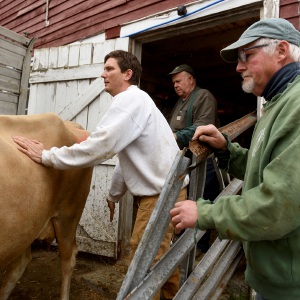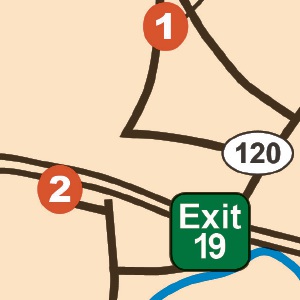Voters to consider housing solutions
| Published: 03-04-2023 8:46 PM |
Housing supply and how to increase it will be an issue at several Town Meetings as voters consider zoning reforms designed to encourage residential development.
Lebanon, Enfield, Hanover, Charlestown and New London all are seeking voter approval of new rules aimed at addressing the region’s housing shortage, which includes a lack of affordable, smaller-sized dwellings such as apartments, townhouses or accessory units.
In interviews last week, municipal officials said that zoning regulations in many Upper Valley communities are too restrictive and are not aligned with modern housing needs.
“The demographics are surely and slowly changing, where people want to go from (living on) big lots to smaller lots,” said Enfield Land Use and Development Director Rob Taylor.
The Enfield Planning Board placed two zoning proposals on this year’s warrant that would support smaller and more economical types of housing.
One proposal would permit an owner-occupied home to have up to two accessory dwelling units, or ADUs, a type of secondary residence such as a basement apartment or a barn converted into a living space. Only one of these ADUs may be physically attached to the main house under the Enfield proposal.
A second zoning proposal would reduce the minimum lot size requirement for a single-family dwelling from a half-acre to a quarter-acre, provided the property can be connected to municipal water and sewer lines.
Since 1970, Taylor said, Enfield’s population has declined. Five decades ago, the average home contained five residents. As of the 2020 census, that ratio is less than two residents per home.
Article continues after...
Yesterday's Most Read Articles
 At Dartmouth, hundreds protest ongoing war in Gaza and express support for academic freedom
At Dartmouth, hundreds protest ongoing war in Gaza and express support for academic freedom
 Herd departs Hartford’s last remaining dairy farm
Herd departs Hartford’s last remaining dairy farm
 Lebanon moves forward with plans for employee housing
Lebanon moves forward with plans for employee housing
 Colby-Sawyer president announces plan to depart
Colby-Sawyer president announces plan to depart
 Windsor man who failed to show up for trial arrested in Hartland
Windsor man who failed to show up for trial arrested in Hartland
“We have a lot of square footage per person (now),” Taylor said. “Our population is basically flat, even though we have had 12 residential units come online (in recent years). We’re building new houses, but we’re not filling them up.”
Lebanon, which will ask voters to consider three housing regulation proposals this month, does not have a lack of housing growth. Instead, city officials said they want to increase the overall diversity of housing options.
Since 2010, Lebanon has added 1,350 units and has approved an additional 1,260 units for development, including the recent approval of a 152-unit apartment complex downtown across from Colburn Park and a 196-unit complex at the former Kleen laundry facility on Mechanic Street.
However, nearly all these new units are expected to be sold or leased at market rate. City officials hope through new zoning proposals to incentivize the development of more economical housing sought by many middle-income professionals, young families or by seniors seeking to downsize their home.
“The market is not having difficulty creating market-rate units,” Lebanon Assistant City Manager David Brooks said. “With these new zoning proposals, we want to provide opportunities (for developers) to create a fuller spectrum of housing types.”
One zoning proposal would permit “cottage developments,” a cluster of small, detached homes built on a single lot and connected by a shared courtyard or similar common space.
This amendment, if approved by voters, would allow clusters composed of three to 16 houses on a lot size of at least one-half acre, with a permitted density of 2,500 square feet per unit.
A second proposal would allow an ADU on an owner-occupied two-family dwelling, such as a duplex. The existing ordinance restricts ADUs to single-family dwellings.
Brooks said the city designed regulations for these housing types “in ways that will fit with our existing neighborhood and that don’t alter their character.”
A third proposal would update city regulations for manufactured housing developments to align with the standards in the city’s existing manufactured housing parks, which provide a housing space of 5,000 square feet per unit. The current city code requires manufactured housing parks to provide a minimum of 10,000 square feet per unit.
Hanover — which holds its Town Meeting in May — will vote on less-burdensome parking requirements for housing, another way to facilitate development.
One proposal, reviewed last week by the Hanover Planning Board, would remove a requirement for ADUs to provide off-street parking for tenants and reduces the minimal parking requirements for downtown residential housing, from one parking space per dwelling unit to one space per two dwelling units, and for student residencies, from a parking space to bed ratio of 1-to-4 to 1-to-8.
In a phone interview, Senior Planner Olivia Uyizeye of the Upper Valley Lake Sunapee Regional Planning Commission said that minimal parking requirements often force developers to reduce the number of housing units because of parking limits. This reduction in units can result in higher rental rates.
Other Hanover proposals include zoning amendments to support rental housing and student residences.
“(These proposals) not only helps address major housing and affordability issues (in our town and the region), but as we talk about in this year’s Town budget process, being proactive and intentional with planning our future revenue growth will help ensure future budget needs don’t overly burden existing taxpayers and help make Hanover more affordable in the future,” said Town Manager Alex Torpey.
In Sullivan County, Charlestown is also exploring how its housing regulations align with the region’s changing demographics and needs.
Charlestown voters will consider two articles at Town Meeting pertaining to housing development.
One article, containing multiple zoning amendment proposals, would expand the allowance of multi-family structures of up to three family dwellings into two new zones. One zone, which contains a watershed, will require a special exception permit from the Zoning Board of Adjustment.
A second article would prohibit new manufactured home parks.
Planning Board Chairperson Patricia Chaffee said this article would not prohibit the expansion of existing manufactured home parks. The town currently has eight parks that vary in size from 20 units to 150 units.
Both proposals originated as recommendations in the 2021 town master plan, which identified “high quality housing,” “a mix of housing types” and “raising the quality of housing stock” among its priorities.
According to the master plan, 31% of Charlestown’s 2,354 housing units in 2020 were mobile homes.
By encouraging more development of “high quality” homes, particularly apartment-style housing, town officials hope to attract more young professionals or families and also increase the town valuation, according to town officials.
“There are a lot of younger professionals who can’t find apartments, as well as medical workers like traveling nurses,” Chaffee said. “We are considered a bedroom community (of the Upper Valley), so having quality housing can not only help increase our town population but the values of our homes.”
New London, in proposed changes to its workforce housing overlay district, is asking voters to consider “density bonuses” as a tool to encourage the development of workforce housing.
Under this plan, multi-family housing developers could receive more favorable density leeway if they dedicate a certain number of their units to workforce housing. In New Hampshire, the sale price or rent of units designated as workforce housing must adhere to affordability rates set by the U.S. Department of Housing and Urban Development, or HUD.
To illustrate this density bonus proposal, town planner Adam Ricker said that if a developer of a 10-unit apartment building agreed to dedicate 30% of the units, totally three, as workforce housing, the density bonus would enable the developer to add an eleventh unit, which could be rented at market rate.
“We have heard loud and clear from our area employers about the difficulty to find employees or housing for them,” Ricker said. “We need to tackle this housing issue, and it’s going to take a lot of variety of housing types and price points.”
Ricker added that addressing the region’s housing crisis necessitates a “cooperative approach” by all the communities.
“No one town can or should have to shoulder the entire responsibility,” he said.
Patrick Adrian may be reached at padrian@vnews.com or at 603-727-3216.

 Sharon voters to decide $9.5 million school building bond
Sharon voters to decide $9.5 million school building bond  Dartmouth graduate student-workers go on strike
Dartmouth graduate student-workers go on strike
